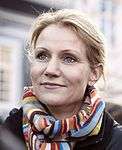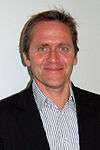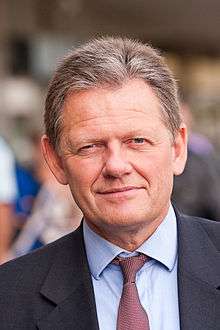Danish general election, 2011
| | ||||||||||||||||||||||||||||||||||||||||||||||||||||||||||||||||||||||||||||||||||||||||||||||||||||||||||||||||||||||||||
| ||||||||||||||||||||||||||||||||||||||||||||||||||||||||||||||||||||||||||||||||||||||||||||||||||||||||||||||||||||||||||
| ||||||||||||||||||||||||||||||||||||||||||||||||||||||||||||||||||||||||||||||||||||||||||||||||||||||||||||||||||||||||||
| ||||||||||||||||||||||||||||||||||||||||||||||||||||||||||||||||||||||||||||||||||||||||||||||||||||||||||||||||||||||||||

General elections were held in Denmark on 15 September 2011 to elect the 179 members of the Folketing. Of those 179, 175 members were elected in Denmark, two in the Faroe Islands and two in Greenland.
The incumbent centre-right coalition led by Venstre lost power to a centre-left coalition led by the Social Democrats making Helle Thorning-Schmidt the country's first female Prime Minister. The Social Liberal Party and the Socialist People's Party became part of the three-party government. The new parliament convened on 4 October, the first Tuesday of the month.
Background
Anders Fogh Rasmussen, who had been re-elected Prime Minister following the 2007 parliamentary election, resigned on 5 April 2009 to become the Secretary General of NATO in August. Polls indicated a preference for early elections over simply having Finance Minister Lars Løkke Rasmussen take over as PM; the Social Democrats' Helle Thorning-Schmidt was also suggested as the preferred candidate for PM.[1] However, Pia Kjærsgaard, the leader of the Danish People's Party, had reiterated the DPP's continued support for the government, previously avoiding a new election and making Rasmussen the PM within the existing parliament.[2] However, when Rasmussen resigned that support became moot.
Date
According to the Danish Constitution, the election had to take place no later than 12 November 2011 since the last Danish election was held on 13 November 2007. The prime minister can call the election at any date, provided it is no later than four years from the previous election. Danish media and political commentators speculated about the timing of the election since Rasmussen took office as Prime Minister in April 2009. The election was called on 26 August 2011, after heavy media speculation.
MPs not seeking re-election
The following had as of March 2010 announced that they would not seek re-election.[3]
- Malou Aamund (Venstre)
- Britta Schall Holberg (Venstre)
- Preben Rudiengaard (Venstre)
- Jens Vibjerg (Venstre)
- Jens Kirk (Venstre)
- Lone Møller (Social Democrats)
- Vibeke Grave (Social Democrats)
- Niels Sindal (Social Democrats)
- Lise von Seelen (Social Democrats)
- Jens Christian Lund (Social Democrats)
- Jens Peter Vernersen (Social Democrats)
- Søren Krarup (Danish People's Party)
- Jesper Langballe (Danish People's Party)
- Lone Dybkjær (Social Liberal Party)
- Niels Helveg Petersen (Social Liberal Party)
- Bente Dahl (Social Liberal Party)
- Jørgen Poulsen (Social Liberal Party)
- Line Barfod (Red-Green Alliance)
Retired MPs
- Mogens Camre (DF)
- Rikke Hvilshøj (V)
- Gitte Seeberg (Independent)
- Mia Falkenberg (DF)
- Anders Fogh Rasmussen (V)
- Morten Messerschmidt (DF)
- Bendt Bendtsen (K)
- Svend Auken (S)
- Morten Helveg Petersen (R)
- Thomas Adelskov (S)
- Lene Hansen (S)
- Knud Kristensen (K)
- Connie Hedegaard (K)
- Søren Gade (V)
Coalitions
The former Prime Minister, Lars Løkke Rasmussen, led a centre-right minority government consisting of the Liberal Party and the Conservative People's Party. This coalition government worked with regular parliamentary support from the national conservative Danish People's Party and often gained the necessary 90th seat for a majority in the Folketing through negotiations with the sole MP from the Christian Democrats Ørum-Jørgensen[4] and independent MP Christmas Møller, both elected in 2007 as conservative MPs and since having defected.
Since the 2007 election, the Liberal Alliance (previously Ny Alliance) had gained momentum in opinion polls, and since early 2010, the governing coalition had not been able to gather a majority in the polls without the support of the Alliance. The continuing rise in the polls was to an extent the result of the internal crisis in the Conservative People's Party over the leadership Lene Espersen[5] and the continuing debate over a lack of true liberal/conservative ideology in government policy.[6]
On 13 January, the continuing turmoil within the Conservative group in the Folketing caused Lene Espersen to resign as political leader of the party and focus on her role as Minister of Foreign Affairs.[7] A leadership election between Brian Mikkelsen, the Minister of Economic and Business Affairs and Lars Barfoed, the Justice Minister, was widely expected,[8] but on 14 January the Conservative group in the Folketing unanimously elected Barfoed as their new political leader. He was formally elected as chairman of the party at a party convention within a few weeks.[9]
The Social Democrats, under the leadership of Helle Thorning-Schmidt, had enjoyed continuing majorities in opinion polls since late 2009 and hoped to form a centre-left government coalition consisting of the Socialist People's Party and the Social Liberal Party with parliamentary support from the small Red-Green Alliance.[10][11]
Both Margrethe Vestager (Social Liberal Party) and Villy Søvndal (Socialist People's Party) pledged their support to Thorning-Schmidt before the election.[12] But there has been considerable debate about the future politics of this coalition, mainly because the Social Liberal Party demands a more liberal economic agenda. Also on immigration issues there are political differences between the three coalition parties. This led some observers to believe that the Social Liberal Party would not join a government coalition but instead opt to be a part of the parliamentary support of a new, centre-left government.[13] In the event the Social Liberals did join the new three-party coalition government formed on 3 October.
Opinion polls
| Polling Firm | Date | Source | Venstre (V) | Social Democrats (A) | Danish People's Party (O) | Socialist People's Party (F) | Conservative People's Party (C) | Social Liberal Party (B) | Liberal Alliance (I) | Red-Green Alliance (Ø) | Christian Democrats (K) | Government | Opposition |
|---|---|---|---|---|---|---|---|---|---|---|---|---|---|
| 2007 Election | 13 Nov 2007 | 26.2% | 25.5% | 13.9% | 13.0% | 10.4% | 5.1% | 2.8% | 2.2% | 0.9% | 53.3% | 46.7% | |
| Capacent | 26 Feb 2010 | [14] | 22.1% | 26.3% | 14.5% | 18.1% | 11.6% | 4.4% | 0.7% | 2.0% | 0.3% | 48.9% | 50.8% |
| Capacent | 31 Mar 2010 | [14] | 23.7% | 26.7% | 13.8% | 17.2% | 10.9% | 4.6% | 0.5% | 2.2% | 0.3% | 48.9% | 50.7% |
| Greens | 7 Jan 2011 | [15] | 21.6% | 29.2% | 14.6% | 13.0% | 4.5% | 7.5% | 5.8% | 3.2% | 0.4% | 46.5% | 52.9% |
| Gallup | 7 Jan 2011 | [16] | 24.3% | 31.3% | 12.2% | 12.7% | 6.0% | 5.5% | 4.3% | 2.9% | 0.8% | 46.8% | 52.4% |
| YouGov | 12 Jan 2011 | [17] | 21.8% | 26.4% | 13.5% | 15.2% | 4.4% | 6.2% | 8.3% | 4.0% | 0.3% | 48.0% | 51.8% |
| Capacent | 12 Jan 2011 | [18] | 23.1% | 29.9% | 13.0% | 13.0% | 5.9% | 5.5% | 4.3% | 4.8% | 0.3% | 46.3% | 53.2% |
| Gallup | 14 Jan 2011 | [19] | 24.6% | 28.6% | 13.0% | 14.9% | 5.7% | 5.8% | 4.0% | 2.9% | 0.5% | 47.3% | 52.2% |
| Voxmeter | 16 Jan 2011 | [19] | 22.9% | 31.1% | 11.8% | 12.3% | 5.7% | 5.6% | 6.3% | 3.7% | 0.0% | 46.6% | 52.7% |
| Greens | 21 Jan 2011 | [20] | 22.6% | 29.5% | 11.6% | 14.2% | 6.5% | 6.5% | 5.4% | 2.7% | 0.4% | 46.1% | 52.9% |
| Gallup | 24 Jan 2011 | [19] | 23.9% | 27.6% | 14.0% | 13.8% | 4.9% | 7.3% | 4.7% | 2.7% | 0.8% | 47.5% | 51.4% |
| Greens | 4 Feb 2011 | [21] | 21.3% | 31.2% | 12.3% | 15.6% | 5.4% | 5.6% | 4.4% | 3.3% | 0.6% | 43.4% | 55.7% |
| Berlingske | 10 Sep 2011 | [22] | 23.6% | 25.5% | 12.4% | 11.1% | 5.9% | 9.3% | 5.1% | 6.4% | 0.8% | 47.8% | 52.3% |
| Berlingske | 10 Sep 2011 | [23] | 23.0% | 25.0% | 13.6% | 9.8% | 5.0% | 10.0% | 5.4% | 7.2% | 0.9% | 47.9% | 52.0% |
| Berlingske | 12 Sep 2011 | [22] | 23.8% | 25.3% | 12.3% | 10.7% | 5.8% | 9.5% | 5.2% | 6.5% | 0.8% | 47.9% | 52.0% |
Results
| Parties | Leaders | Votes | % | Seats | ± | |
|---|---|---|---|---|---|---|
| Denmark proper | ||||||
| Liberals (Venstre, Danmarks Liberale Parti) (V) | Lars Løkke Rasmussen | 947,725 | 26.7% | 47 | +1 | |
| Social Democrats (Socialdemokraterne) (A) | Helle Thorning-Schmidt | 879,615 | 24.8% | 44 | −1 | |
| Danish People's Party (Dansk Folkeparti) (O) | Pia Kjærsgaard | 436,726 | 12.3% | 22 | −3 | |
| Danish Social Liberal Party (Det Radikale Venstre) (B) | Margrethe Vestager | 336,698 | 9.5% | 17 | +8 | |
| Socialist People's Party (Socialistisk Folkeparti) (F) | Villy Søvndal | 326,192 | 9.2% | 16 | −7 | |
| Red-Green Alliance (Enhedslisten) (Ø) | Collective leadership | 236,860 | 6.7% | 12 | +8 | |
| Liberal Alliance (Liberal Alliance) (I) | Anders Samuelsen | 176,585 | 5.0% | 9 | +4 | |
| Conservative People's Party (Det Konservative Folkeparti) (C) | Lars Barfoed | 175,047 | 4.9% | 8 | −10 | |
| Christian Democrats (Kristendemokraterne) (K) | Per Ørum Jørgensen | 28,070 | 0.8% | 0 | ±0 | |
| Candidates without parties | 1,850 | 0.1% | 0 | ±0 | ||
| Red Alliance (A, B, F, Ø) | Helle Thorning-Schmidt | 1,779,365 | 50.2% | 89 | +8 | |
| Blue Alliance (C, I, K, O, V) | Lars Løkke Rasmussen | 1,764,153 | 49.8% | 86 | −8 | |
| Invalid votes | 34,307 | |||||
| Subtotal (Turnout: 87.7% – electorate: 4,079,910) | 3,545,368 | 100.0% | 175 | |||
| Faroe Islands | ||||||
| Union Party (Sambandsflokkurin) (B) | Kaj Leo Johannesen | 6,361 | 30.8% | 1 | ±0 | |
| Social Democratic Party (Javnaðarflokkurin) (C) | Aksel Johannesen | 4,328 | 21.0% | 1 | +1 | |
| Republic (Tjóðveldi) (E) | Høgni Hoydal | 3,998 | 19.4% | 0 | −1 | |
| People's Party (Fólkaflokkurin) (A) | Jørgen Niclasen | 3,932 | 19.0% | 0 | ±0 | |
| Centre Party (Miðflokkurin) (H) | Jenis av Rana | 872 | 4.2% | 0 | ±0 | |
| Self-Government Party (Sjálvstýrisflokkurin) (D) | Kári á Rógvu | 481 | 2.3% | 0 | ±0 | |
| Candidates without parties | 672 | 3.3% | 0 | ±0 | ||
| Invalid votes | 301 | |||||
| Subtotal (Turnout: 58.9% – electorate: 35,044) | 20,644 | 100.0% | 2 | |||
| Greenland | ||||||
| Inuit Community (Inuit Ataqatigiit) | Kuupik Kleist | 9,780 | 42.7% | 1 | ±0 | |
| Forward (Siumut) | Aleqa Hammond | 8,499 | 37.1% | 1 | ±0 | |
| Democrats (Demokraatit) | Jens B. Frederiksen | 2,882 | 12.6% | 0 | ±0 | |
| Feeling of Community (Atassut) | Finn Karlsen | 1,728 | 7.5% | 0 | ±0 | |
| Candidates without parties | 24 | 0.1% | 0 | ±0 | ||
| Invalid votes | 612 | |||||
| Subtotal (Turnout: 57.4% – electorate: 40,935) | 22,913 | 100.0% | 2 | |||
| Overall | ||||||
| Red Alliance (A, B, F, Ø, Siumut, Inuit Ataqatigiit, Javnaðarflokkurin) | Helle Thorning-Schmidt | 1,801,972 | 50.2% | 92 | ||
| Blue Alliance (V, O, I, C, K, Union Party) | Lars Løkke Rasmussen | 1,770,514 | 49.3% | 87 | ||
| Total (Turnout: 87.2% – electorate: 4,156,735) | 3,588,919 | 100.0% | 179 | |||
All turnout figures include invalid votes, subtotals and totals exclude invalid votes
Reactions
Helle Thorning-Schmidt told a group of supporters: "We did it. Make no mistake: We have written history. Today there’s a change of guards in Denmark." Incumbent Prime Minister Lars Løkke Rasmussen congratulated Thorning-Schmidt after conceding defeat: "So tonight I hand over the keys to the prime minister’s office to Helle Thorning-Schmidt. And dear Helle, take good care of them. You’re only borrowing them."[29]
The Copenhagen Stock Exchange did not react adversely despite a fear of increased public spending and higher taxes because the election result was largely expected.[30]
Analysis
The result was seen as leading to a possible roll back of some austerity programmes initiated by the previous government amidst the European sovereign debt crisis. The new majority for the leftist block deprived the Danish People's Party of the kingmaker role it held under the previous government and used to tighten Danish immigrations policy. However, fundamental changes were not expected, as the Danish political consensus would maintain the welfare system in Denmark that is financed by high taxes.[29] The state of the economy was also seen as a key factor for the anti-incumbent vote.
Danish newspapers such as Berlingske also asked if a Red Bloc coalition could survive its tenure with the "sharp differences between [the] parties." It wrote that "with a parliamentary basis consisting of parties in deep mutual dispute over the most important questions in society, the election victory last night could turn out to be a short-lived triumph for Thorning-Schmidt."[30]
Government formation
Though the Liberal Party remained the single largest party with the addition of one seat and the Social Democrats lost a seat, a three-party coalition of opposition parties together with the supporting Red-Green Alliance had a larger share of seats than the incumbent liberal-conservative coalition with support of the Danish People's Party.[31] Prime Minister Lars Løkke Rasmussen then tendered the cabinet's resignation to Queen Margrethe II on 16 September,[32] following which she met with the various parties and tasked Social Democrat leader Helle Thorning-Schmidt with the formation of a new government.[30] Rasmussen's cabinet would remain in office as a caretaker government until 3 October, when Thorning-Schmidt's cabinet, announced on 2 October, would be sworn in making her the country's first ever female Prime Minister.[29] The Social Liberal Party and the Socialist People's Party also became a part of the governing coalition.[33] The new parliament, by law, convened on the first Tuesday in October.
References
- ↑ (03/02/09) (22 February 2009). "Danes Want Election if Rasmussen Steps Down | Angus Reid Public Opinion". Angus-reid.com. Retrieved 8 August 2011.
- ↑ DF siger god for Løkke som statsminister (16 February 2009) (Danish). Politiken.
- ↑ De bliver valgt ved folketingsvalg nu Altinget.dk 6. marts 2003
- ↑ "Kristendemokraterne vil med i finansloven" (in Danish). Politiken.dk. 26 July 2011. Retrieved 8 August 2011.
- ↑ "Lene Espersens krise smitter af på Løkke - Politiko | www.b.dk". Berlingske.dk. Retrieved 8 August 2011.
- ↑ Af Uffe Tang og Christian Brøndum. "Liberal Alliance redder regeringen - Politiko | www.b.dk". Berlingske.dk. Retrieved 8 August 2011.
- ↑ Af Lene Frøslev. ""Det er den rigtige beslutning" - Politiko | www.b.dk". Berlingske.dk. Retrieved 8 August 2011.
- ↑ Af Morten Henriksen og Chris Kjær Jessen. "Både Barfoed og Brian vil afløse Lene - Politiko | www.b.dk". Berlingske.dk. Retrieved 8 August 2011.
- ↑ Af Louise Lyck Dreehsen. "Barfoed taler til pressen - Politiko | www.b.dk". Berlingske.dk. Retrieved 8 August 2011.
- ↑ "Rød dominans - Politik" (in Danish). BT.dk. 13 June 2010. Retrieved 8 August 2011.
- ↑ "Greens: Markant rødt flertal - dr.dk/Nyheder/Politik". Dr.dk. Retrieved 8 August 2011.
- ↑ "Vestager peger på Helle Thorning". Borsen.dk. 20 October 2008. Retrieved 8 August 2011.
- ↑ "Radikale med i regering - hvis ... - dr.dk/Nyheder/Politik". Dr.dk. 19 August 2010. Retrieved 8 August 2011.
- 1 2 "Fortsat flertal til Thorning - dr.dk/Nyheder/Politik". Dr.dk. Retrieved 8 August 2011.
- ↑ MortenStryhn. "Konservative i historisk nedsmeltning". Borsen.dk. Retrieved 8 August 2011.
- ↑ "Se Gallup-målingen her - Politiko | www.b.dk". Berlingske.dk. Retrieved 8 August 2011.
- ↑ Thomas Ambrosius. "De Konservative er spillet af brættet – metroXpress". Metroxpress.dk. Retrieved 8 August 2011.
- ↑ "Blokke står uændret efter efterlønsdebat - dr.dk/Nyheder/Politik". Dr.dk. Retrieved 8 August 2011.
- 1 2 3 "Seneste nyt om politik - politiken.dk Læs seneste nyt om dansk politik og EU på politiken.dk. Nyheder fra Christiansborg, kommuner, regioner og Bruxelles" (in Danish). Politiken.dk. Retrieved 8 August 2011.
- ↑ "Vælgerne straffer Pia Kjærsgaard". Borsen.dk. 21 January 2011. Retrieved 16 September 2011.
- ↑ "Thorning sender blå blok til tælling". Borsen.dk. Retrieved 16 September 2011.
- 1 2 "Meningsmåling, politik, partier - Berlingske Barometer". www.b.dk. Retrieved 16 September 2011.
- ↑ http://www.b.dk/ /
- ↑ "Folketingsvalg torsdag 15. september 2011". dst.dk. Statistics Denmark. Retrieved 16 September 2011.
- ↑ "Kringvarp.fo - Valúrslit". kringvarp.fo. Kringvarp Føroya. Retrieved 16 September 2011.
- ↑ "Letter to Statistics Denmark regarding the Faroese election results" (PDF). dst.dk. Statistics Denmark. Retrieved 16 September 2011.
- ↑ "Folketingimut qinersineq 2011-mi inernerit". knr.gl. KNR. Retrieved 16 September 2011.
- ↑ "Letter to Statistics Denmark regarding the Greenlandic election results" (PDF). dst.dk. Statistics Denmark. Retrieved 16 September 2011.
- 1 2 3 "Denmark to get 1st female PM after left wins vote", Dawn, 16 Sep 2011, retrieved 5 Oct 2011
- 1 2 3 Fraende, Mette; Gaunt, Jeremy (17 Sep 2011), "Denmark elects first female PM", The Gazette (Montreal), retrieved 5 Oct 2011
- ↑ http://links.org.au/node/2501
- ↑ http://news.xinhuanet.com/english2010/world/2011-09/16/c_131143125.htm
- ↑ Acher, John (1 October 2011). "Danish PM-elect seen unveiling govt Sunday -agency". Reuters.
External links
- Election polling and trends on politiken.dk
- NSD: European Election Database - Denmark publishes regional level election data; allows for comparisons of election results, 1990–2011
.jpg)

.jpg)
.jpg)


